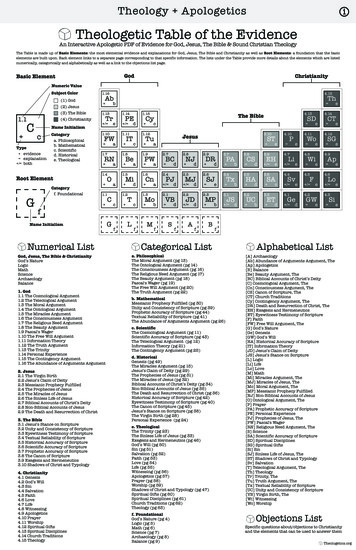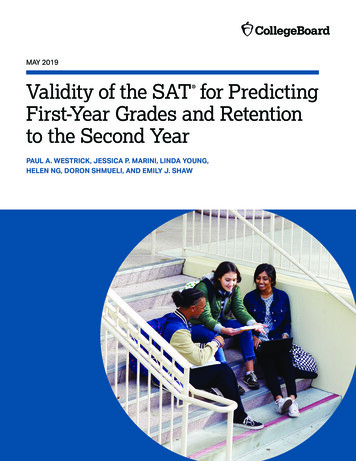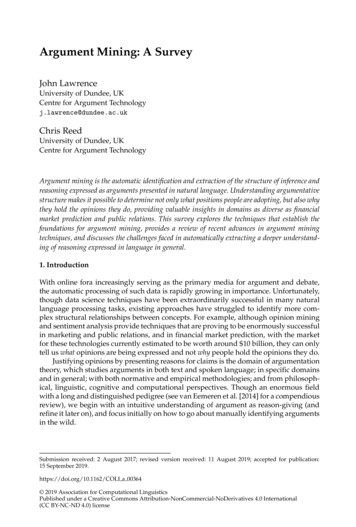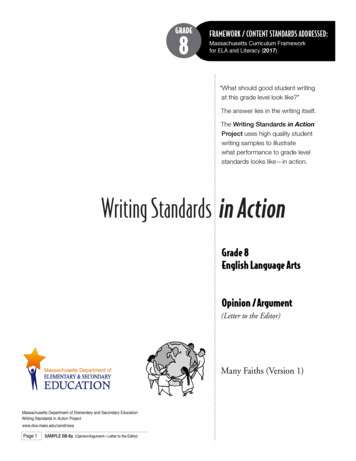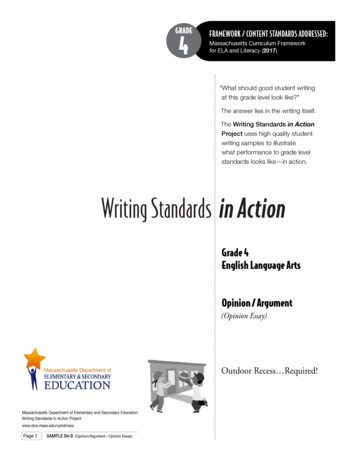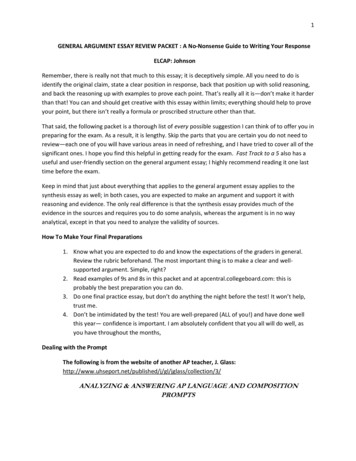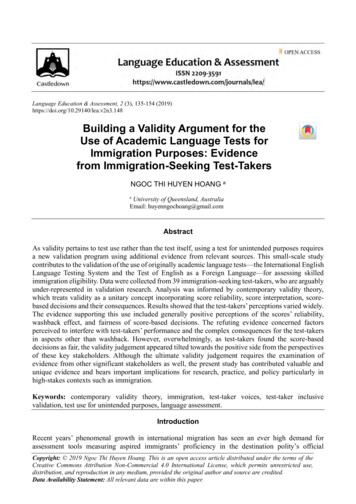
Transcription
Language Education & Assessment, 2 (3), 135-154 g a Validity Argument for theUse of Academic Language Tests forImmigration Purposes: Evidencefrom Immigration-Seeking Test-TakersNGOC THI HUYEN HOANG aaUniversity of Queensland, AustraliaEmail: huyenngochoang@gmail.comAbstractAs validity pertains to test use rather than the test itself, using a test for unintended purposes requiresa new validation program using additional evidence from relevant sources. This small-scale studycontributes to the validation of the use of originally academic language tests—the International EnglishLanguage Testing System and the Test of English as a Foreign Language—for assessing skilledimmigration eligibility. Data were collected from 39 immigration-seeking test-takers, who are arguablyunder-represented in validation research. Analysis was informed by contemporary validity theory,which treats validity as a unitary concept incorporating score reliability, score interpretation, scorebased decisions and their consequences. Results showed that the test-takers’ perceptions varied widely.The evidence supporting this use included generally positive perceptions of the scores’ reliability,washback effect, and fairness of score-based decisions. The refuting evidence concerned factorsperceived to interfere with test-takers’ performance and the complex consequences for the test-takersin aspects other than washback. However, overwhelmingly, as test-takers found the score-baseddecisions as fair, the validity judgement appeared tilted towards the positive side from the perspectivesof these key stakeholders. Although the ultimate validity judgement requires the examination ofevidence from other significant stakeholders as well, the present study has contributed valuable andunique evidence and bears important implications for research, practice, and policy particularly inhigh-stakes contexts such as immigration.Keywords: contemporary validity theory, immigration, test-taker voices, test-taker inclusivevalidation, test use for unintended purposes, language assessment.IntroductionRecent years’ phenomenal growth in international migration has seen an ever high demand forassessment tools measuring aspired immigrants’ proficiency in the destination polity’s officialCopyright: 2019 Ngoc Thi Huyen Hoang. This is an open access article distributed under the terms of theCreative Commons Attribution Non-Commercial 4.0 International License, which permits unrestricted use,distribution, and reproduction in any medium, provided the original author and source are credited.Data Availability Statement: All relevant data are within this paper.
136Language Education & Assessment, 2(3)language (Extra, Spotti, & Van Avermaet, 2009; Shohamy & McNamara, 2009). Yet, standardisedlanguage tests designed specifically for immigration remain scarce. Therefore, most immigrationcountries rely on existing language tests, which are intended for other purposes, even against testdevelopers’ guidelines for appropriate use. For example, the most widely used tests for processingmigration visas—the International English Language Testing System (IELTS) and the Test of Englishas a Foreign Language (TOEFL)—are originally designed for academic purpose (i.e., assessingprospective students’ readiness for English-medium secondary education).The use of a test for purposes which it is not intended for raises critical questions about validity, afundamental concern in testing and assessment (AERA, APA, & NCME, 2014). A test for academicpurposes is designed so as to yield data to support inferences about the test-taker’ ability to uselanguage in universities and colleges. Using this test to screen immigrants involves making inferencesabout test-takers’ capacity to use English as immigrants in the destination country based on inferencesabout their ability to use English in academic settings. While there is arguably some overlap betweenthese two domains, a certain degree of misfit is inevitable since no test fits multiple purposes perfectly(AERA et al., 2014; Koch, 2013). Fulcher and Davidson (2009) emphasise that in such cases, a new,separate validity argument needs to be constructed to avoid test misuse and abuse. It is thus crucial tovalidate the use of standardised academic language tests for assessing skilled migration eligibility,which to date has been under-researched. Such validity inquiry contributes to the making of wellinformed visa grant decisions which are fair to immigration-seeking test-takers and ultimately benefitimmigration countries (Shohamy & McNamara, 2009).Contemporary validity theory (AERA et al., 2014) holds that validation must involve examination ofboth the technical (i.e., test reliability and suitability for the purposes in question) and the social aspects(i.e., reasonableness of test use and its social impact). In addition, making a sound, unbiased validityjudgement requires a compelling, comprehensive body of validity evidence, and the adequaterepresentation of multiple stakeholders (AERA et al., 2014; Kane, 2006; Messick, 1989). Of all thekey stakeholders, test-takers are the only ones to experience the test first-hand (Nevo, 1995) and areprofoundly affected by the test score use (Kane, 2002), thus are considered the most importantstakeholders in language testing (Rea-Dickins, 1997). Nonetheless, they have not been adequatelyrepresented in validation research(Cheng & DeLuca, 2011).The current study seeks to fill the existing research gaps by investigating both technical and socialdimensions of the use of academic language tests for immigration purposes from the perspective ofimmigration-seeking test-takers. It aims to answer the overarching research question of “How valid isthe use of academic language tests for immigration purpose, through the lens of immigration-seekingtest-takers?”To situate this study within the broader literature, the next section reviews the expanding validationstudies on language-in-immigration. Then a brief description of the methodology is provided, followedby the discussion of the results and some insight into the unified validity judgement. The concludingremarks close the paper with a set of recommendations for key stakeholders and suggestions for furtherresearch.Validity of the Use of Language Testing in ImmigrationPrevious studies on language testing in the domain of immigration can be categorised into three broadgroups according to which element of this phenomenon they focus on. The first group deals withtechnical features of tests and the test administration process; the second investigates rationales forsetting language requirements for immigrants; while the third scrutinises its consequences.
Hoang: Building a validity argument for the use of academic language tests for immigration purposes137One of the earliest studies in the first group is Merrylees (2003), which examined the suitability of theIELTS test for immigration purposes from the perspectives of two test-taker groups, one taking the testfor immigration and the other for education in the UK. In particular, it explored these two groups’general attitudes and perceptions of the test as a whole as well as its four components in terms ofdifficulty, suitability of the topic, time allocation, and potential interferences with test performance. Itwas concluded that “The overall impression given about the IELTS test was positive with a numberof comments made about the appropriacy and effectiveness of the IELTS test for immigrationpurposes.” (p. 36) However, this conclusion was drawn from the observation that the immigrationseeking group, like the other group, showed a general appreciation of the test’s reliability. Indeed, thesurvey focused exclusively on the test per se with no direct reference to its use for assessingimmigration eligibility. This conclusion contradicts the results of a qualitative study by Rumsey,Thiessen, Buchan, and Daly (2016). Based on interviews with health industry stakeholders and healthprofessional immigrants in the Australian context, this study showed overall negative perceptions ofthe IELTS as a test for immigration. Concerns were raised about the IELTS’s scoring protocols, whichwere believed to be not consistent, “like gambling” by some participants (p. 100). In addition,participants in both groups indicated that the IELTS test was not relevant to their work contexts, andthus, not a suitable testing tool for migrants working in healthcare. This was in agreement with Readand Wette (2009), which found a general perception among health professionals seeking permanentmigration in New Zealand that “neither [the Occupational English Test (OET) or the IELTS] is, in anyreal sense, a test of their ability to communicative effectively in clinical contexts” (p. 3). In the samevein, Müller (2016) emphasised that achievement of satisfactory scores does not guarantee successfulcommunication in clinical settings because language proficiency constitutes “a core pillar, rather thanthe sole contributor, of communicative competence” (p. 132). A similar argument was made aboutlanguage requirement for visa in the meat production industry by Piller and Lising (2014), who rightlypointed out thatLanguage at work is governed by a corporate regime and language in migration is governed bythe state. These language regimes do not always operate in sync and sometimes even conflict.(p. 37)The second group of studies on language testing in immigration context explore the rationales ormotivations for introducing the language element in the processing of visa and citizenship applications,although they do not always link it to validity. Merrifield (2012) found that the immigration authoritiesof major English-speaking countries considered “easier settlement, integration into the hostcommunity and contribution to workforce knowledge” (p. 1) as main reasons for relying onstandardised tests like the IELTS to screen intending immigrants. The usefulness and convenience ofchanging cut-off scores to manipulate the number of immigrants accepted and control immigrationpatterns was considered another important reason. Other studies (e.g., Berg, 2011; Blackledge, 2009;Capstick, 2011; Hunter, 2012) revealed similar motivations such as addressing skilled labour shortage,fostering destination countries’ economic development, enhancing immigrants’ active participation inthe labour market, ensuring that they meet occupational health and safety standards, enabling them toaccess their full rights, and reducing costs for welfare systems.Beyond economic reasons, a number of studies (e.g., Blackledge, 2009; McNamara, 2009; Shohamy,2013; Shohamy & McNamara, 2009; Slade & ering, 2010) unpacked a ran ge of social andpolitical reasons behind language legislations for migration. They pointed out that requiring thenewcomers to be proficient in the language of the receiving society is commonly claimed by politiciansto uphold social cohesion, national identity and security often associated with monolingualism (Berg,2011; Shohamy, 2013). As such, raising language requirements for immigrants appears to be an easy
138Language Education & Assessment, 2(3)and low-cost measure to deal with today’s increasingly formidable challenges of balancing economicbenefits with political stability. Ndhlovu (2008), based on a critical discourse analysis of Australia’slanguage-in-migration policies throughout history, illustrated how language testing could be and hasbeen often (ab)used for racial exclusion, explicit or subtle.It is also notable that there remains little evidence to support the wide variety of rationales forlanguage-in-migration policy. An Australian study by Chowdhury and Hamid (2016) challengescommon public discourses about the vital role of English proficiency in immigrants’ social integrationand economic contribution. It clearly demonstrated that low English proficiency Bangladeshiimmigrants in Australia were able to develop social and communication strategies to achievesatisfactory work, economic, and social life in the host society. On the other side of the story, Hoangand Hamid (2016) investigated two exceptional cases of prospective immigrants. Both had beenresiding in Australia for an extended period of time, secured good jobs, and enjoyed Australian sociallife. Yet they were unable to fulfil IELTS sub-score requirements for skilled visa after multiple attempts.The fundamental questions of the test’s suitability for immigration and the “fairness” of language-inmigration policy were thus raised. Looking beyond the issue of language at the workplace, Gribble,Blackmore, Morrissey, and Capic (2016) discovered that non-linguistic factors deriving from the hostcommunity including workplace discrimination and isolation, rather than immigrants’ language ability,played the most significant role in new immigrants’ entry into the labour market and integration intothe destination society. The disconnect between language proficiency and social integration andemployability identified in the above studies suggest that the often-cited rationales for languagerequirements for immigrants might be untenable.The third major strand of research delves into impact of the use of language testing in migrationscreening. Capstick (2011) documented the experiences of four learners of English struggled to meetthe UK government’s tightened language legislation for spousal visa applicants. The study showed thepolicy’s differentiating effects on the immigrants and the receiving country: while it allowed the UKto benefit economically from immigrants’ skilled low-wage labour and helped politicians gain electoraladvantage by appearing to be tough on immigration issues, it denied “members of transnationalfamilies the right to marry by choice” and practically prevented many from uniting with their spousealready residing in the UK (Capstick, 2011, p. 3). Hoang and Hamid (2016) demonstrated significantfinancial, emotional-psychological, social-relationship, and other consequences of Australia’slanguage-in-migration policy in two exceptional cases. Substantial affective impacts on immigrationseeking test-takers including depression, self-doubt, and negative self-perceptions were reported in thestudy by Rumsey et al. (2016). Inappropriate policies may backfire on immigration countries as well.Hoang and Hamid (2016) suggested that Australia’s skilled migration scheme risked failing to achieveits goal of addressing skilled labour shortage if qualified, capable immigrants were denied visa solelyon the basis of their language test results. Berg (2011) pointed out that a rigid language-in-migrationpolicy had detrimental impact on the receiving country’s cultural and linguistic diversity, whichparadoxically, is considered in need of protection. She further argued that such use of language testingcould lead to xenophobic attitudes and social and racial exclusion, as only those who speak thatcountry’s language are accepted into the society. Questions of human rights were also raised whenproficiency in the immigration country’s language prospective is made an entry requirement.It is noteworthy that while previous studies have provided valuable evidence, few have explored bothtechnical and social dimensions of the use of language testing for assessing migration eligibility, whichis essential for a unified judgement of its validity.
Hoang: Building a validity argument for the use of academic language tests for immigration purposes139MethodologyThe Cases: IELTS and TOEFLIELTS and TOEFL can be seen as archetypes of originally academic English tests used for immigrationpurposes, taken annually by millions of people over the globe (Educational Testing Service, 2018;IELTS Partners, 2018). IELTS claims to be “the high-stakes English test for study, migration or work”(IELTS Partners, 2018) i . It is the only internationally available English proficiency certificationaccepted by Citizenship and Immigration Canada. It also remains the preferred test by the immigrationauthorities of Australia, New Zealand, and the UK, although a few other tests are also accepted (IELTSPartners, 2018; Merrifield, 2012). These other tests are also not specifically designed for immigration,and thus validity issues encountered they are used for immigration screening should be similar to whenIELTS and TOEFL are. TOEFL is not officially stated to be a test for migration and was not used forthis purpose when the data for the current study were collected yet is now accepted for skilledmigration in Australia, New Zealand, and the UKii. Score requirements for skilled migration vary fromone country to another. Australia requires a minimum IELTS score of 6.0 across all components or aTOEFL score of at least 12 in listening, 13 in reading, 21 in writing, and 18 in speaking as proof ofcompetent Englishiii. For New Zealand, it is 6.5 in all IELTS components or a total score of 79 inTOEFLiv. The UK requires 6.5 across the IELTS components or 110 in TOEFLv. Canada appears lessstrict, as a score of 4.0 for speaking and 4.5 for listening on the IELTS general training module isacceptablevi.ParticipantsThe research reported in this paper is drawn from a larger mixed-methods study. The parent studyinvolved 517 people coming from and residing in over 50 countries/territories who took IELTS andTOEFL for different purposes (e.g., higher education, scholarship application, professional registrationor employment). The current paper examines only the use of these tests in the immigration domain.It involves 39 test-takers (16 female and 23 male), who reportedly had taken IELTS or TOEFL forimmigration. They came from 14 countries including Vietnam, India, the Philippines, Germany, Italy,and the UK. Five participants identified themselves as native speakers of English, who sat the test togain bonus points in the point-based system for skilled migration. The sample was reasonablyhomogeneous in terms of social class, with the majority of participants belonging to middle or highermiddle classes. Most of them were high scorers but over one third remained unsuccessful in obtainingthe scores they targeted for migration.Data Collection and AnalysisAll the participants completed an online survey (phase 1) and six continued to follow-up individualinterviews (phase 2). The survey sought information about 1) the participants’ demographic detailsand experiences of taking the tests; 2) their perceptions of issues related to test reliability; and 3) theirperceptions of test use and its consequences. Most of the survey items were constructed on a Likertscale, but there was also an open question (optional) at the end of each major sections asking for furthercomments, explanation, or elaboration. In total, 37 open comments were received. The in-depthinterviews were semi-structured to ensure that the main topic was maintained while the informants hadthe opportunity to freely express themselves (Creswell & Plano Clark, 2011; Lichtman, 2010). Thismeans that many questions were not prepared in advance but emerged from the participants’ answersto earlier questions in the interview. Thus, the set of questions differed from one interview to another
140Language Education & Assessment, 2(3)(see a sample interview protocol in Appendix A). Each interview lasted from 1.5 to 2.5 hours. Boththe survey and the interviews used lay language, taking heed of the common concern that a typicaltest-take might not be familiar with linguistic and assessment-specific terminologies and highlytechnical concepts. Where necessary, efforts were made to explain these concepts to make sure thatthe test-takers understood them properly before offering their views.The qualitative data were analysed using content analysis with the help of NVivo. The analysisfollowed the six-stage procedure for systematic qualitative data coding proposed by Strauss and Corbin(1990). Specifically, after the data were gathered (stage 1), the interviews were transcribed,pseudonyms assigned to the participants, and data imported to NVivo (stage 2). The data were thenfragmented (i.e., broken down into smaller chunks or meaningful parts and coded as free nodes inNVivo – stage 3) before they were categorised using axial coding strategy (stage 4). For the purposeof this study, the codes were aligned with the theoretically drawn components of validity (i.e., theoverarching themes of test reliability and test score use, and the themes subsumed under them). As thestudy focused on validation, the data were further categorised as positive, negative, or neutral, whichrepresented the participants’ perceptions (i.e., whether they supported or rejected those particularelements of the tests and their use). Next (stage 5), they were linked (i.e., establishing the relationshipsbetween the codes through inductive process) and in the final stage, themes were generated. Due tothe limited scope of this paper, the discussion of the results focuses only on validity-related themes.Results and DiscussionPerceptions of Test ReliabilityPerceived test reliability was conceptualised in consistence with the three inferential links concerningscore reliability in Kane’s (2006) validation framework: evaluation, generalization, and extrapolation.As such, three survey items were used to seek the test-takers’ perceptions of: 1) how effectively thetests measured their English ability at the time of taking them; 2) how well the scores reflected theirtest performance; and 3) how well the scores predicted their English ability in the target context. Theresponses are presented in Table 1.Table 1 Test-takers’ perceptions of the tests’ reliabilityAspects ofreliabilityEffective measureAccurate scoresPredictivity(Strongly)agree19 (49%)18 (46%)14 (36%)Neutral8 (21%)11 (28%)9 (23%)(Strongly)disagree12 (31%)10 (25%)14 (36%)Don’t know/don’tremember/non-response002 (5%)As the table shows, nearly half of the participants believed that the tests effectively measured theirEnglish proficiency and that the scores accurately reflected their test performance but just over onethird of them found the scores predictive of how well they would use English in the target context. Thelow ratings for the test scores’ predicting power could signify test-takers’ perceptions of the mismatchbetween the domain of use intended by the tests (i.e., mainly academic) and that of their actual use(i.e., immigration). There was a clear tendency to consider the tests as reliable but not completely so.The reasons for this general perception were further examined by a survey item aiming to ascertainwhether test performance and scoring were affected by the various factors identified in the literature.Table 2 displays responses to this question.
Hoang: Building a validity argument for the use of academic language tests for immigration purposes141Table 2 Potential interferences with test performance and scoring (n rceived inferences with test performanceUnfamiliarity with tests16 (41%)14 (36%)8 (21%)1 (3%)Testing condition25 (64%)6 (15%)8 (21%)0Test administration19 (49%)15 (39%)5 (13%)0Test structure18 (46%)13 (33%)8 (21%)0Test content/topics10 (26%)16 (41%)13 (33%)0Question types12 (31%)16 (41%)11 (28%)0Feelings while taking tests7 (18%)12 (31%)20 (51%)0Perceived inferences with test scoreScoring system5 (13%)17 (44%)15 (39%)2 (5%)Consistency between raters5 (13%)17 (44%)14 (36%)3 (8%)It appears that in the test-takers’ view, the following factors did not significantly affect test reliability:1) the testing condition (specified in the survey as factors such as room configuration, noise and lightin the test room and sound quality); 2) test administration procedure (e.g., checking identity, usheringexaminees to test rooms and seats, distributing and collecting test materials, and instructions for testtakers); and 3) test structure (e.g. constituent sections of each test, number of questions per section,order of questions, and time allocations). Lack of familiarity with the tests could also be considered aninsignificant factor, as only eight test-takers (21%) reported considerable interference. The remainingfactors were perceived to compromise the tests’ reliability to varying degrees, as will be discussed inthe following sections.Test Content/TopicsWhile some test-takers stated that topical knowledge largely determined one’s performance on the tests,others posited that unfamiliarity with or lack of knowledge of the test topics would put the test-takerat a disadvantage. All the interviewees indicated that they would have performed better if the topicshad been related to their field of study or work. However, in IELTS and TOEFL, test-takers are notgiven choices over the test topics in any sections. Thus, many of them believed “luck” (in the form ofhaving a familiar topic) could largely affect their ability to demonstrate their language ability. Thisview is consistent with the findings of many studies on the potential effect of subject/topical knowledge(either alone or in interaction with other factors such as one’s language proficiency) on testperformance (Alderson & Urquhart, 1985; Bachman & Palmer, 2010; Huang, Hung, & Plakans, 2018;Jensen & Hansen, 1995; Karimi, 2016), which could be considered a source of invalidity (Jennings,Fox, Graves, & Shohamy, 1999).Question TypesSome test-takers identified certain discrepancy between the tests’ intended and their actual domains ofuse. For instance, I34, who took the academic module of IELTS, stated that the test questions were toogeneral for its purpose (i.e., academic). Yet, I33, a test-taker of IELTS general training module
142Language Education & Assessment, 2(3)maintained that the test tasks were too complex for real-life language encounters of a typical immigrant.Interestingly, apart from these comments, very few references to question types were made.Feelings while Taking the TestsIt is not surprising that feelings were most commonly reported to affect the test-takers’ performance,given the high-stakes nature of these tests. Test-takers’ feelings were investigated through a surveyitem asking the respondents to use at least three words or phrases to describe how they felt while takingthe tests. The question was responded with a considerable number of words that denote positivefeelings such as confident, calm, and relaxed. However, these were outnumbered by those conveyingnegative feelings including anxious, tired, stressed, scared, nervous, uncomfortable, annoyed, andangry. The main reasons for these feelings, as self-reported by the test-takers, included the time, effort,and money they had invested in the tests and the anticipated consequences of failure to achieve desiredscores. I9’s reflection on her eight times sitting IELTS without success illustrates this impact mostclearly:[Because IELTS]’s gonna change your life, it really causes you a lot of pressure and worry [.]and sometimes you don’t focus on the test, you just keep telling yourself “I need to pass, I needto pass” and then you don’t pass! [.] If your body reacts to this kind of thing, you can’t thinkclearly. You just know [.] you need to pass IELTS otherwise you have to go home. And youcan’t concentrate although you have studied for it.This quote reflects Shohamy’s (2001b) observation that test-takers have a clear sense of thegatekeeping role and power of these tests in their life, which invokes anxiety, fear, and a feeling ofhelplessness. The participants were fully aware of how these negative feelings impacted on theirperformance yet failed to control them. While impact of psychological state on test performance hasbeen documented in an extensive body of research er & Pekrun, 2004; von der Embse & Witmer,2014; Zeidner, 1998), the current study further indicates that it tends to be more severe when the testresults are used to make such life-changing decisions as granting migration permission.ScoringAlthough the scoring of IELTS and TOEFL is routinely inspected and “endorsed” by considerableresearch mostly by in-house research teams and external researchers vii, the test-takers in the presentstudy did not display a high trust in it. Nearly four fifths of them believed that the scoring system andthe marking consistency to some extent affected their scores. The transparency of the marking processwas frequently questioned, probably because IELTS and TOEFL do not provide feedback to test-takers.Survey respondent I16 made a strong point that, “The speaking test and writing test are subjective. Wedon’t know the exact result of how we were going on the test. Need to have a specific result explainedto the examinees.” Some IELTS test-takers believed that they did not receive a right/fair score for thespeaking part due to the lack of professionalism of speaking examiners. I34, who speaks English asthe first language, raised the issue of the examiner’s inappropriate attitude and behaviour ondiscovering that she was taking the IELTS for Australian migration. It was on this occasion that shereceived a significantly lower score for speaking (7.5) than on all other sittings (8.5). Another IELTStest-taker, I37, indicated that he performed worse than expected because of the “apparently sluggishand bored” examiner’s attitude. These perceptions corroborate findings of previous studies thatlanguage speaking test examiners vary in their elicitation of test-takers’ response which affects testtakers’ performance as well as examiners’ judgement of their language ability (e.g., A. Brown, 2003).The lack of standardisation across examiners echoed in this test-taker study signifies potential threatsof test bias which need to be considered and rectified.
Hoang: Building a validity argument for the use of academic language tests for immigration purposes143Notably, like participants in Rumsey et al.’s (2016)
communication in clinical settings because language proficiency constitutes “a core pillar, rather than the sole contributor, of communicative competence” (p. 132). A similar argument was made about language requirement for visa in the meat production industry

